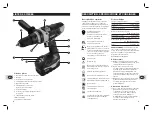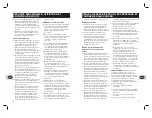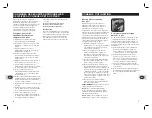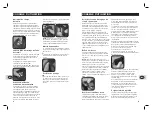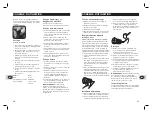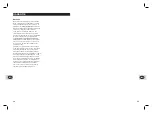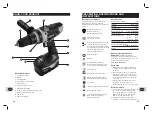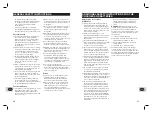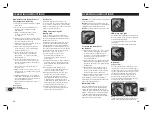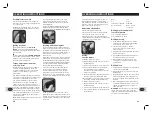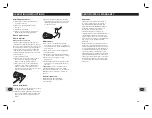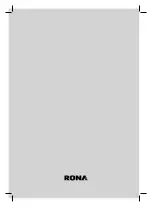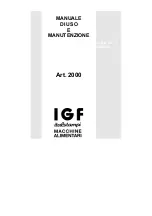
16
GB
17
GB
be recharged only with the specified
charger for the battery. A charger that may
be suitable for one type of battery may
create a risk of fire when used with
another battery.
c) Use battery operated tool only with
specifically designated battery pack. Use of
any other batteries may create a risk of fire.
Personal safety
a) Stay alert, watch what you are doing and
use common sense when operating a
power tool. Do not use tool while tired or
under the influence of drugs, alcohol, or
medication. A moment of inattention while
operating power tools may result in serious
personal injury.
b) Dress properly. Do not wear loose clothing
or jewelry. Contain long hair. Keep your hair,
clothing, and gloves away from moving
parts. Loose clothes, jewelry, or long hair
can be caught in moving parts.
c) Avoid accidental starting. Be sure switch
is off before plugging in. Carrying tools
with your finger on the switch or plugging
in tools that have the switch on invites
accidents.
d) Remove adjusting keys or wrenches before
turning the tool on. A wrench or a key that
is left attached to a rotating part of the tool
may result in personal injury.
e) Do not overreach. Keep proper footing and
balance at all times. Proper footing and
balance enables better control of the tool in
unexpected situations.
f) Use safety equipment. Always wear eye
protection. Dust mask, non-skid safety
shoes, hard hat, or hearing protection must
be used for appropriate conditions.
Tool use and care
a) Use clamps or other practical way to secure
and support the workpiece to a stable
platform. Holding the work by hand or
against your body is unstable and may lead
to loss of control.
b) Do not force tool. Use the correct tool for
your application. The correct tool will do the
job better and safer at the rate for which it
is designed.
c) Do not use tool if switch does not turn it on
or off. Any tool that cannot be controlled
with the switch is dangerous and must
be repaired.
d) Disconnect the plug from the power source
before making any adjustments, changing
accessories, or storing the tool. Such
preventive safety measures reduce the risk
of starting the tool accidentally.
e) Store idle tools out of reach of children
and other untrained persons. Tools are
dangerous in the hands of untrained users.
f) Maintain tools with care. Keep cutting tools
sharp and clean. Properly maintained tools,
with sharp cutting edges are less likely to
bind and are easier to control.
g) Check for misalignment or binding of
moving parts, breakage of parts, and
any other condition that may affect the
tools operation. If damaged, have the tool
serviced before using. Many accidents are
caused by poorly maintained tools.
h) Use only accessories that are
recommended by the manufacturer for your
model. Accessories that may be suitable
for one tool, may become hazardous when
used on another tool.
Service
a) Tool service must be performed only by
qualified repair personnel. Service or
maintenance performed by unqualified
personnel could result in a risk of injury.
b) When servicing a tool, use only identical
replacement parts. Follow instructions in
the Maintenance section of this manual.
Use of unauthorized parts or failure to
follow Maintenance Instructions may create
a risk of electric shock or injury.
GENERAL SAFETY INSTRUCTIONS
Safety rules for cordless
drill/drivers
a) Hold tool by insulated gripping surfaces
when performing an operation where the
cutting tools may contact hidden wiring or
its own cord. Contact with a “live” wire will
make exposed metal parts of the tool “live”
and shock the operator.
b) Always wear safety goggles or eye
protection when using this tool. Use a dust
mask or respirator for applications which
generate dust.
c) Secure the material being drilled. Never
hold it in your hand or across legs. Unstable
support can cause the drill bit to bind
causing loss of control and injury.
d) Position yourself to avoid being caught
between the tool or side handle and walls
or posts. Should the bit become bound or
jammed in the work, the reaction torque of
the tool could crush your hand or leg.
e) If the bit becomes bound in the workpiece,
release the trigger immediately, reverse the
direction of rotation and slowly squeeze the
trigger to back out the bit. Be ready for a
strong reaction torque. The drill body will
tend to twist in the opposite direction as the
drill bit is rotating.
f) Do not grasp the tool or place your hands
too close to the spinning chuck or drill bit.
Your hand may be lacerated.
g) When installing a drill bit, insert the shank of
the bit well within the jaws of the chuck. If
the bit is not inserted deep enough, the grip
of the jaws over the bit is reduced and the
loss of control is increased.
h) Do not use dull or damaged bits and
accessories. Dull or damaged bits have a
greater tendency to bind in the workpiece.
i) When removing the bit from the tool avoid
contact with skin and use proper protective
gloves when grasping the bit or accessory.
Accessories may be hot after prolonged
use. Check to see that keys and adjusting
wrenches are removed from the drill before
switching the tool on. Keys or wrenches
can fly away at high velocity striking you or
a bystander.
j) Do not run the drill while carrying it at your
side. A spinning drill bit could become
entangled with clothing and injury may
result.
WARNING!
Some dust created by power
sanding, sawing, grinding, drilling, and other
construction activities contains chemicals
known to cause cancer, birth defects or other
reproductive harm. Some examples of these
chemicals are:
a) Lead from lead-based paints,
b) Crystalline silica from bricks and cement
and other masonry products, and
c) Arsenic and chromium from chemically
treated lumber.
Your risk from these exposures varies,
depending on how often you do this type
of work. To reduce your exposure to these
chemicals: work in a well ventilated area, and
work with approved safety equipment, such as
those dust masks that are specially designed
to filter out microscopic particles.
ADDITIONAL SAFETY INSTRUCTIONS FOR THE
CHARGER AND BATTERIES
Summary of Contents for 2001516
Page 13: ......


